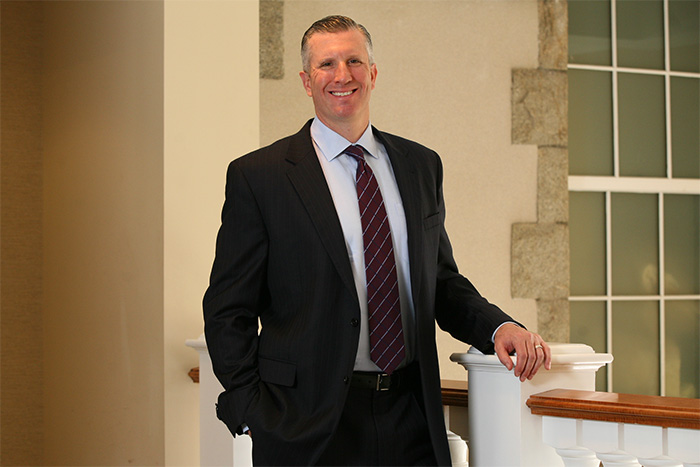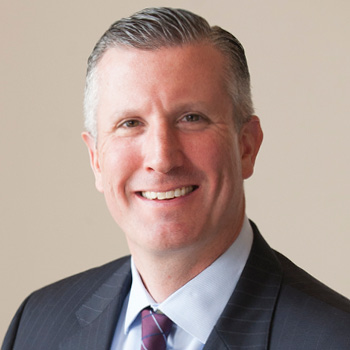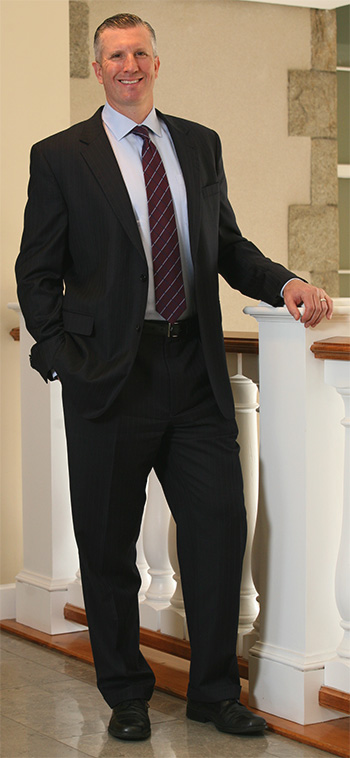Planning for all of life’s stages

Kevin M. McGrady, CLU, CRPC, ChFC • Cranston, RI
Integrated Financial Partners • Lincoln Financial Advisors Corp.
Read full biography below
Proactive Advisor Magazine: Kevin, what factors have shaped your personal growth as an advisor?
I received my degree in business administration, with a concentration in computer information systems. I was always interested in the financial markets on a personal level, and my initial career path intersected with firms that were in financial services. Though I was not on a track to become an advisor initially, one of my early positions was involved with planning events and meetings for a fast-growing and innovative financial firm. Through that job, I was fortunate enough to interact with senior financial planners who were very successful and loved what they were doing. I decided then and there that being a financial advisor was something I wanted to do as a career.
I am a strong proponent of continuing education and learning as much as possible from trusted mentors. I have always tried to figure out what courses of study and designations would be the most valuable and meaningful for me, and I pursued those aggressively from the start. Thankfully, the business model I participated in early on paired senior advisors with junior advisors to work jointly with clients on planning cases. I am proud of the fact that I moved through that phase relatively quickly.
The rest is history, although there were some twists and turns in terms of settling in at one firm. I joined Integrated Financial Partners (IFP) in 2008 and have the utmost respect for its people, its business model, and its approach to financial planning. I have a great relationship with IFP and Lincoln Financial, and I look forward to many productive and rewarding years together serving clients.

What kinds of clients do you tend to work with, and how do you develop new prospects?
Our client base is primarily individual clients, couples, and families, though I also work with many business clients. The core market is represented by pre-retirees and retirees, ranging in age from 50 to 75. We also work with a small niche of clients above the age of 75, addressing elder-care needs and financial planning for those that might be exposed to high costs for a nursing home or other care facility.
We often work with local estate-planning attorneys on those kinds of elder-care planning issues. In general, we work with attorneys and CPAs using a team approach for our clients. That is a prime area for referrals for all parties involved, and we have established many strong relationships there. Referrals from these attorneys, accountants, and our current clients are how we grow our practice. I would say in all of those relationships, our philosophy of making a planning model the first priority is a real asset and something that helps drive referrals. All of these constituencies tend to come away very impressed with our dedication to a disciplined planning process and the tools we use along the way.
“What counts is the targeted level of returns that will help clients meet their financial objectives, not the return of any one asset class in any given year.”
Please describe how you approach financial and investment planning.
First of all, it is process-driven. We follow a specific model and methodology at IFP. It is not focused on transactions; we do not address a client’s potential investment strategy until we have thoroughly developed the financial plan.
One core process we use in developing the plan is called the Lifetime Income Model. One of the key elements of the process is figuring out what we call the “necessary” and “excess” estates for a client or couple. The necessary estate is what our process indicates will be the assets needed to fund a client’s income needs for the rest of their lives. The excess estate is exactly that—what is left over from their assets that will likely be passed along to their heirs or charity. So, in the example of working with an estate attorney, we can come up with some fairly accurate numbers on both the necessary and excess estate.
I can tell the attorney, for example, that a client I am working with, who might be worth $5 million, is probably going to need $3 million of that during their lifetime to fund a lifestyle that is appropriate and comfortable. The extra $2 million is excess, and it is important in this example that we figure out a way to pass that along effectively to their children. So, what do we do with this $2 million? The tools or investments we use with those assets may be very different from creating a distribution strategy for the initial $3 million. That is a very shorthand version of the big picture.

In all cases, this is a highly personalized process. The first stage of that is for a client or client couple to become comfortable with me, our firm, and how we like to work with clients. That usually happens fairly quickly, and we can then get into the discovery process and begin using several tools to develop the overall financial plan.
There are two very important pieces of our process that I emphasize with clients. First, while we work on an initial plan right away, that plan effectively becomes a living document. We need to make sure we stay on top of any new developments in their lives or changes in circumstances. We also want to reassure a client that we are going to work closely with them to monitor their progress toward their goals over time, and, if need be, we will make adjustments along the way.
The second point goes back to our belief in having strong working relationships with attorneys and accountants. We will tell clients that we would like to bring their other trusted advisors into the process where necessary. I call this a “three-factor approach to planning,” and clients really appreciate the effort in this regard. We want to be there as the quarterback for the client, bringing all of these parties together because the best-designed plan is really going to ensure that all of those parties are communicating effectively.
There are really no constraints on what we can use. Again, the strategies we use depend on the plan and each individual client’s needs, objectives, and overall financial picture. But I will give you an example of an investment approach that is representative.
In addition to the concepts I’ve already explained, our Lifetime Income Model is predicated on tranches or buckets. These are basically divided into five-year time periods, with the first five-year bucket consisting of assets that have to be highly liquid and in very conservative investment vehicles. These assets will fund the retirement income needs for that first five years. As we move further out on the time spectrum, each five-year bucket can move beyond the most conservative investments, and we use a blend of many different investment vehicles. These could be some form of an annuity; REITs; fixed income; passive funds; or active, tactical money management in either the fixed or equity asset classes.
We tend to use very conservative return estimates as a firm. And we work very hard to educate clients and set expectations. We know we will have years when a certain asset class or investment strategy will underperform or overperform. The diversification of our investment plan and our ability to make adjustments along the way allows us to deal effectively with that reality. And many of the tactical investment strategies we use have their own particular strategy for risk management and decreasing overall volatility for a client portfolio. Therefore, we have several different ways of handling market volatility or variations in asset-class performance over time.
I will often show clients a multiyear Callan chart, which shows annual returns for various asset classes, ranked from best to worst. It quickly becomes apparent to clients that even though, say, large-cap equities have been on a strong run for most of the last five years, they were down in the area of 40% in 2008. It graphically depicts the need for diversification and a plan that uses risk management and multiple investment approaches.
The real key to all of this working is setting proper expectations with our clients. What counts is the targeted level of returns that will help them meet their financial objectives, not the return of any one asset class in any given year. My mantra over and over with clients is simply, “stay patient and disciplined and let the plan work for you.” I feel that is a message I am able to effectively communicate, and this can help our clients increase their probabilities for success over the long term.
 Kevin McGrady is a financial planner with Integrated Financial Partners Inc., and a registered representative of Lincoln Financial Advisors Corp. With 19 years of experience in executing financial strategies for individuals, families, and businesses, he and his team can help provide clients with “a comprehensive roadmap to their financial future.”
Kevin McGrady is a financial planner with Integrated Financial Partners Inc., and a registered representative of Lincoln Financial Advisors Corp. With 19 years of experience in executing financial strategies for individuals, families, and businesses, he and his team can help provide clients with “a comprehensive roadmap to their financial future.”
Mr. McGrady specializes in retirement accumulation and distribution strategies, family protection, and business-succession planning. He bases his practice on the philosophy of working conservatively with clients in order to achieve realistic financial goals. Mr. McGrady says his ongoing commitment to education allows him to continually inform his clients of changes in the industry and in the economy. He says, “Being this type of resource has enabled our firm to sustain long-term relationships with clients.”
A graduate of Bryant University, where he studied business administration and computer information systems, Mr. McGrady has also earned the designations of Chartered Life Underwriter (CLU), Chartered Retirement Planning Counselor (CRPC), and Chartered Financial Consultant (ChFC). He has been listed as a “Five Star Wealth Manager” in Rhode Island Monthly Magazine for three consecutive years.
Mr. McGrady lives with his wife and two daughters in North Kingstown, Rhode Island. He says much of his spare time is spent “keeping up with the 50 directions our kids always seem to be running in.” He enjoys “being an active supporter of their many activities and a sponsor in several areas.” An accomplished athlete in high school and college, Mr. McGrady also likes to spend time generally staying fit, running, and biking.
Disclosure: Kevin McGrady is a registered representative of Lincoln Financial Advisors Corp. Securities and investment advisory services offered through Lincoln Financial Advisors Corp., a broker/dealer (member SIPC) and registered investment advisor. Insurance offered through Lincoln affiliates and other fine companies. It is not our position to offer legal or tax advice. IFP is not an affiliate of Lincoln Financial Advisors Corp. CRN-1547286-071416
Photography by Mae Gammino


